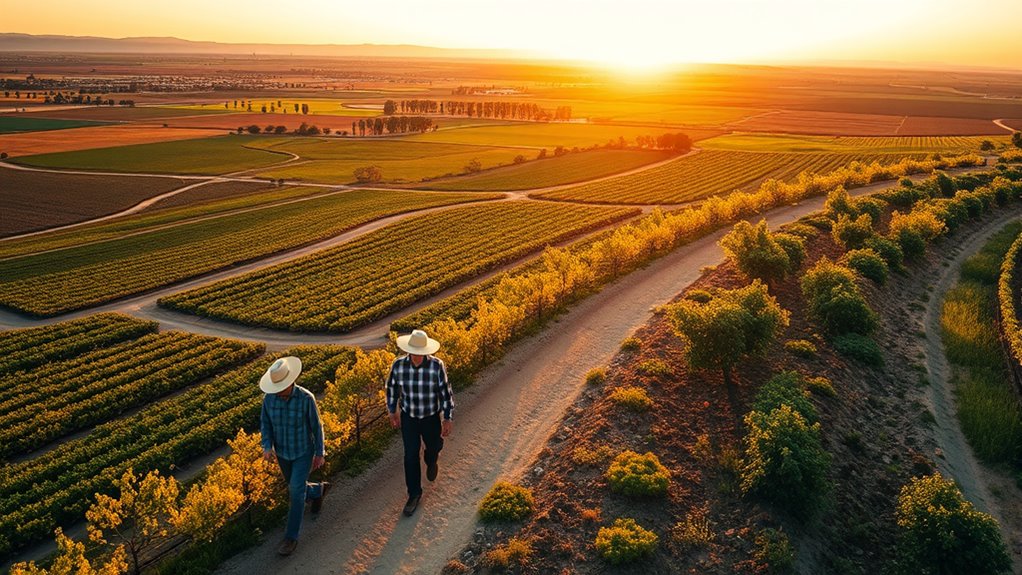Regenerative agriculture tours in California’s Central Valley let you see firsthand how farmers restore soil health, promote biodiversity, and reduce chemical use. You’ll explore farms practicing crop rotation, cover cropping, composting, and innovative equipment that minimizes soil disturbance. These visits highlight water conservation efforts and native habitat restoration, showing how sustainable practices benefit ecosystems and climate resilience. Keep exploring to discover how these farms are transforming agriculture and how you can be part of it.
Key Takeaways
- Experience farm tours showcasing regenerative practices like cover cropping, composting, and no-till equipment in California’s Central Valley.
- Learn from leading farms implementing sustainable water management, crop diversity, and soil health restoration techniques.
- Engage with local farmers and experts to understand ecological benefits and community impacts of regenerative agriculture.
- Participate in farm-to-table visits highlighting nutrient-rich, sustainably produced foods supporting soil and ecosystem health.
- Plan visits with guided or self-guided options, focusing on native habitat restoration, biodiversity, and innovative sustainable practices.
Exploring the Principles of Regenerative Agriculture in the Central Valley

Regenerative agriculture in California’s Central Valley focuses on restoring soil health and boosting ecosystem resilience through sustainable practices. You’ll see how crop diversification plays a essential role, reducing reliance on a single crop and breaking pest cycles naturally. By rotating different crops, farmers improve soil nutrients and create habitats that support beneficial insects, which helps with pest management. These practices minimize chemical use and strengthen the farm’s overall health. Instead of combatting pests with pesticides, farmers encourage natural predators and biodiversity to keep pests in check. This holistic approach aligns with regenerative principles, emphasizing the importance of healthy soil, diverse crops, and integrated pest management. You’ll observe how these strategies work together to create sustainable, resilient farming systems in the Central Valley.
Key Farms Leading the Regenerative Movement
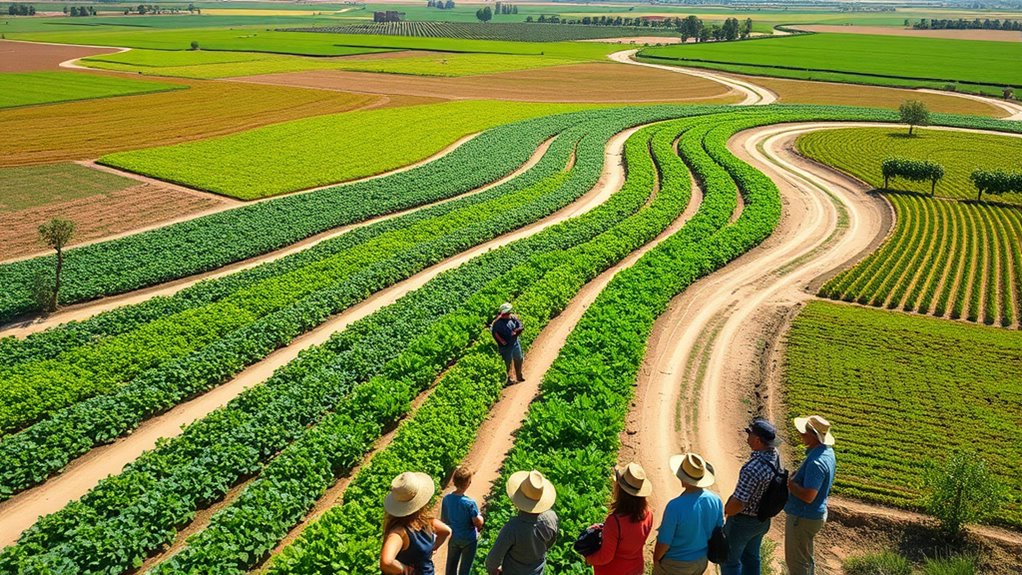
Several farms in California’s Central Valley are leading the way in regenerative agriculture, demonstrating how sustainable practices can transform large-scale farming. These farms invest in innovative farm equipment designed to reduce soil disturbance and improve resource efficiency. They also implement integrated pest management techniques that minimize chemical use while promoting natural pest control methods. By adopting cover cropping, crop rotation, and composting, these farms enhance soil health and biodiversity. Their commitment to regenerative principles proves that large-scale operations can be both productive and environmentally responsible. As you visit, you’ll see firsthand how these farms leverage modern equipment and pest management strategies to create resilient, sustainable systems. Their leadership inspires others to rethink conventional farming and embrace regenerative practices. Incorporating diverse soil health practices is essential for maintaining long-term productivity and ecological balance.
What Visitors Can Expect on a Regenerative Agriculture Tour
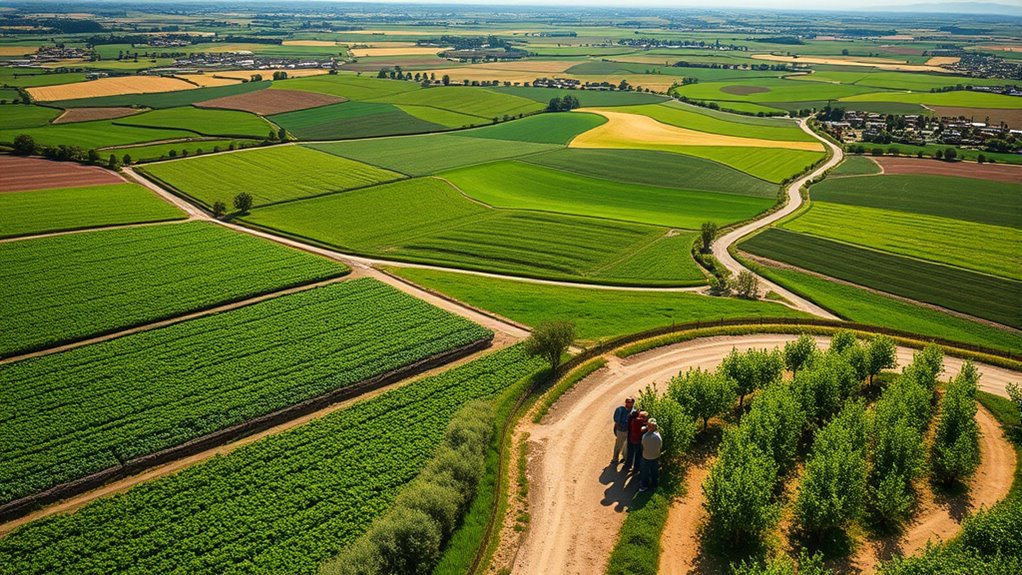
On a regenerative agriculture tour, you’ll participate in farm activities that showcase sustainable farming practices. You’ll also get to enjoy local food experiences that highlight the region’s fresh, nutrient-rich produce. Expect an engaging and informative day focused on eco-friendly techniques and community connections. Additionally, you’ll learn about soil health and its crucial role in regenerative farming methods.
Farm Tour Activities
When you join a regenerative agriculture tour in California’s Central Valley, you’ll have the opportunity to explore working farms firsthand. You’ll see how farm equipment is used efficiently to support soil health and crop diversity. As you walk through the fields, you’ll observe a variety of crop varieties grown using regenerative methods, showcasing the farm’s commitment to biodiversity. You might get to handle tools or see machinery like no-till planters and cover crop seeders in action. Throughout the tour, guides will explain how each activity contributes to soil restoration and farm resilience. This hands-on experience allows you to understand the practical aspects of regenerative farming, making the connection between innovative practices and healthier, more sustainable agriculture.
Sustainable Farming Practices
A regenerative agriculture tour offers a close-up look at sustainable farming practices that prioritize soil health and environmental stewardship. You’ll see methods like integrated pest management, which reduces chemical use and promotes natural control. Machinery efficiency is also emphasized, with equipment designed to minimize soil disturbance and conserve resources. These practices help build resilient ecosystems while maintaining productivity. Expect to observe cover cropping, crop rotation, and composting, all aimed at enhancing soil fertility. Sustainable farming isn’t just good for the planet—it also boosts farm resilience and profitability. Here’s a quick overview:
| Practice | Benefit |
|---|---|
| Pest management | Reduces chemical reliance, promotes natural control |
| Machinery efficiency | Minimizes soil disturbance, conserves resources |
| Cover cropping | Prevents erosion, improves soil health |
| Crop rotation | Breaks pest cycles, improves yield |
| Composting | Enriches soil, reduces waste |
Additionally, observing regenerative practices demonstrates how farmers can align productivity with environmental benefits.
Local Food Experiences
As you explore regenerative farms in California’s Central Valley, you’ll get a firsthand look at how sustainable practices directly connect to the local food you enjoy. You’ll see how farm-to-table initiatives bring fresh, organic produce straight from the fields to your plate, supporting local farmers and reducing carbon footprints. Tours often include visits to nearby local markets, where you can taste and purchase seasonal, locally grown foods. These experiences highlight the importance of supporting regional agriculture and understanding the journey from soil to supper. Expect to learn about how regenerative methods enhance crop quality, soil health, and biodiversity, all while providing delicious, nutritious foods. Additionally, understanding vetted and safe farming practices can deepen your appreciation for the quality and safety of the foods you consume. This connection between farming practices and your dining table makes your tour both educational and flavorful.
Soil Health and Its Impact on Crop Quality
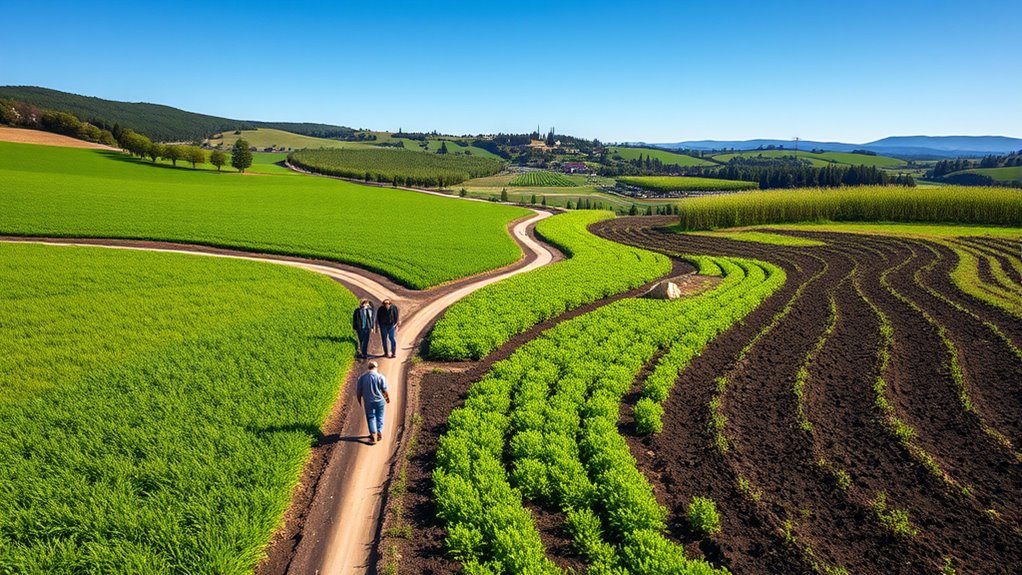
Healthy soil teems with diverse microbes that can increase your crop yields, making your harvest more abundant. Adding organic matter helps reveal essential nutrients, boosting crop quality naturally. When erosion is minimized, your soil stays rich and resilient, supporting healthier plants over time.
Microbial Diversity Boosts Yield
Microbial diversity in soil plays a crucial role in enhancing crop yields and improving overall soil health. When soil microbes thrive, they break down organic matter, fix nitrogen, and suppress pests, leading to healthier plants. Increased microbial diversity creates a lively soil ecosystem that supports robust crop growth. Imagine a farm where microbial activity is high, and plants flourish because of this unseen teamwork. Here’s a snapshot of soil microbial diversity:
| Soil Microbes | Benefits | Impact on Crops |
|---|---|---|
| Bacteria | Nitrogen fixation | Stronger plant growth |
| Fungi | Decomposition of organic matter | Better nutrient uptake |
| Actinomycetes | Disease suppression | Reduced crop loss |
| Protozoa | Nutrient recycling | Increased yield |
| Archaea | Stress tolerance | Resilient crops |
Harnessing microbial diversity boosts yields and ensures healthier, more productive soil. Understanding microbial interactions is essential for developing sustainable agricultural practices.
Organic Matter Enhances Nutrients
Organic matter is crucial for enriching soil nutrients and promoting robust crop growth. When you apply compost or organic amendments, you improve nutrient availability and foster healthy root development. This organic matter acts as a slow-release source of essential nutrients like nitrogen, phosphorus, and potassium, supporting plant vitality. Regular compost application boosts microbial activity, enhancing nutrient cycling and soil structure. Using organic amendments also helps retain moisture and reduces the need for synthetic fertilizers. Additionally, increasing organic matter can improve the soil’s nutrient retention and availability, creating a resilient soil ecosystem that naturally supports crop quality.
Reduced Erosion Preserves Soil
Reducing erosion is essential for maintaining soil health and ensuring high crop quality. When erosion is controlled, you protect valuable topsoil from washing away during heavy rains or strong winds. Proper erosion control methods, like cover cropping and contour farming, help preserve soil structure and prevent degradation. Soil preservation efforts keep nutrients in place, supporting healthy plant growth and better yields. By minimizing erosion, you also reduce the need for frequent soil replacement or intensive remediation, saving costs and resources. Healthy soil that’s protected from erosion offers better water retention and aeration, which benefits crops directly. Implementing effective erosion control techniques supports long-term soil sustainability, ensuring you maintain fertile land for future seasons and promote resilient, productive agriculture. Additionally, soil stability is crucial for preventing further land degradation and maintaining the overall integrity of farmland.
Biodiversity Initiatives and Native Habitat Restoration

As regenerative agriculture practices gain momentum in California’s Central Valley, efforts to enhance biodiversity and restore native habitats play a crucial role. You’ll see projects planting native grasses that provide food and shelter for local pollinators and birds. Restoring native habitats encourages wildlife movement, creating wildlife corridors that connect fragmented ecosystems. These initiatives help preserve rare plant species and support resilient ecosystems. By integrating native plants and habitat features, farms become havens for biodiversity. Additionally, promoting sustainable farming practices can further strengthen ecological health and long-term productivity.
Water Conservation and Management Strategies
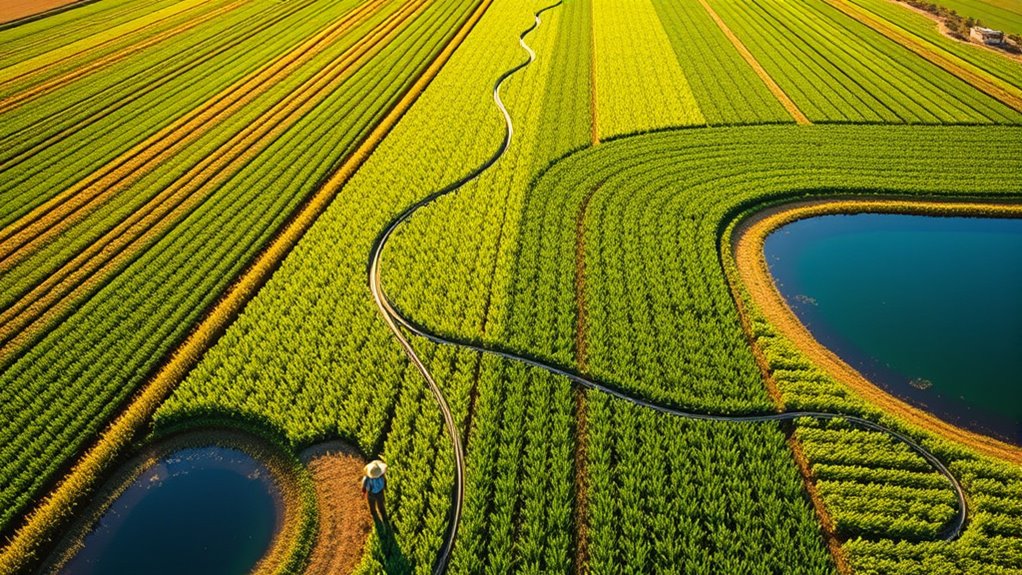
Building on efforts to restore native habitats and support biodiversity, water conservation has become a key focus for farms in California’s Central Valley. You’ll see farmers adopting drip irrigation systems that deliver water directly to plant roots, reducing waste and evaporation. Water recycling also plays a critical role, allowing farms to reuse treated wastewater for irrigation, which conserves fresh water resources. Hydration is crucial; water intake aids in maintaining optimal brain function. These strategies help minimize water use during dry seasons and drought periods, ensuring sustainable crop production. By implementing efficient irrigation and recycling practices, farms can considerably lower their water footprint while maintaining productivity. Your visit highlights how innovative water management techniques are essential for the region’s resilience and long-term health of the ecosystem, emphasizing the importance of responsible water use in regenerative agriculture.
The Role of Cover Crops and Crop Rotation
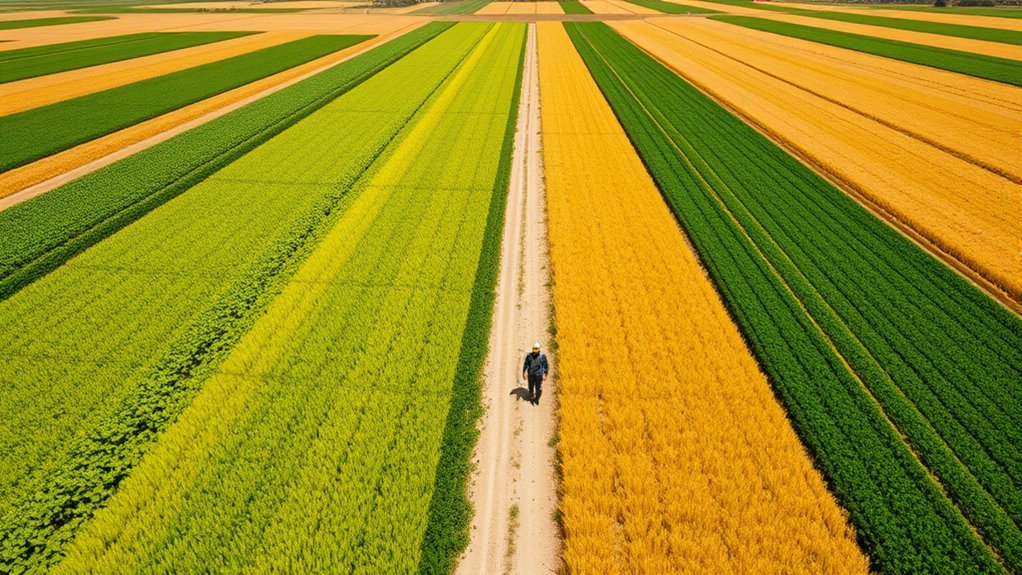
Cover crops and crop rotation are essential tools in regenerative agriculture that enhance soil health and boost farm resilience. By carefully selecting cover crop benefits and designing effective crop rotation schedules, you improve soil structure, suppress weeds, and increase nutrient cycling. Incorporating cover crops like legumes or grasses adds organic matter and fixes nitrogen naturally. Crop rotation helps break pest and disease cycles, reducing chemical dependence. Planning diverse crop sequences protects against crop failure and maintains soil fertility. Additionally, understanding the relationships between different crops and soil health can further optimize these practices. Planning diverse crop sequences protects against crop failure and maintains soil fertility.
How Regenerative Practices Mitigate Climate Change

Regenerative practices help fight climate change by improving soil health and capturing carbon from the atmosphere. They also lower greenhouse gas emissions and support diverse ecosystems that strengthen resilience. By adopting these methods, you can actively contribute to a healthier, more stable climate.
Soil Carbon Sequestration
Soil carbon sequestration is a crucial process through which regenerative agriculture helps combat climate change. By adopting practices like cover cropping, you increase organic matter in the soil, which enhances its ability to store carbon. Cover crop benefits include protecting soil from erosion, improving water retention, and feeding soil microbial life, which accelerates carbon uptake. Healthy microbial activity breaks down organic residues, converting them into stable soil carbon. This process not only reduces atmospheric carbon but also boosts soil fertility. To deepen your understanding, consider these points:
- The role of diverse cover crops in maximizing carbon storage
- How soil microbial communities enhance sequestration efficiency
- Techniques to increase soil organic matter sustainably
- The long-term climate benefits of maintaining healthy soils
Reduced Greenhouse Gases
By adopting practices like reduced tillage, crop rotation, and integrated livestock management, farmers actively lower greenhouse gas emissions from their operations. These regenerative techniques minimize soil disturbance and improve carbon storage, directly reducing methane and nitrous oxide emissions. Pursuing organic certification further supports emission reductions by eliminating synthetic fertilizers and pesticides that release greenhouse gases. Farm diversification also plays a key role, spreading risks and optimizing resource use, which decreases reliance on energy-intensive monocultures. Together, these practices create a more resilient farm system that captures carbon and cuts emissions, helping to combat climate change. As you visit these farms, you’ll see how regenerative agriculture not only enhances soil health but also contributes considerably to greenhouse gas mitigation efforts.
Enhanced Biodiversity
When farmers adopt practices like cover cropping, diversified planting, and habitat buffers, they create habitats that support a wide range of plant and animal species. This approach enhances biodiversity by providing shelter and food sources for native pollinators and other wildlife. Establishing wildlife corridors connects fragmented habitats, allowing species to migrate safely and maintain healthy populations. These practices also promote the presence of native pollinators, which are essential for crop pollination and ecosystem resilience. Additionally, diverse plantings reduce pest outbreaks naturally, decreasing reliance on chemicals. By fostering these ecosystems, regenerative agriculture not only boosts ecological health but also helps mitigate climate change by increasing carbon sequestration and stabilizing local climates.
- Creation of wildlife corridors
- Support for native pollinators
- Increased habitat connectivity
- Reduced need for chemical inputs
Engaging With Farmers and Learning About Sustainable Techniques
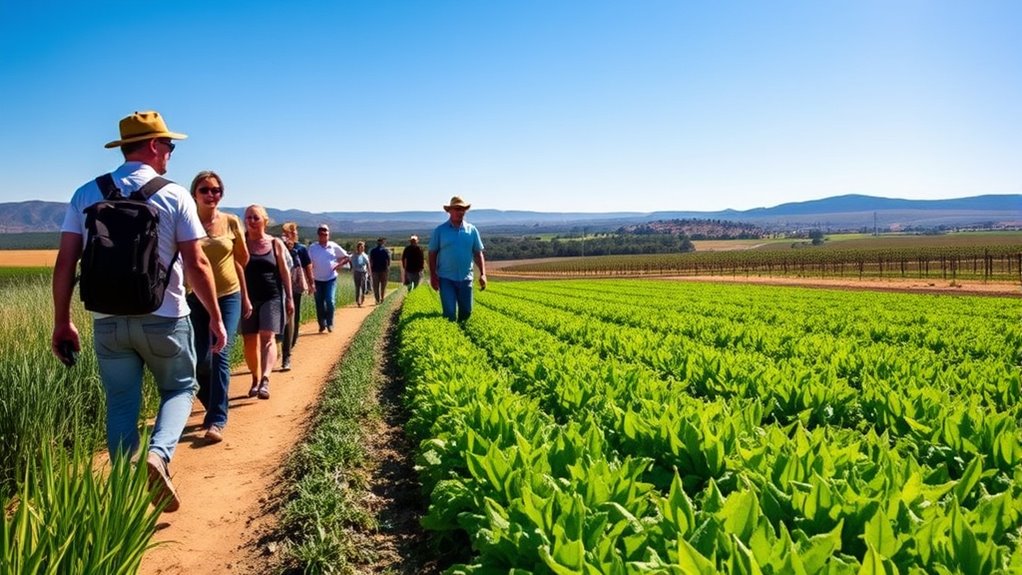
Visiting local farmers offers a firsthand look at how sustainable techniques are transforming agriculture in California’s Central Valley. When you engage with farmers, you’ll see how they use innovative farm equipment designed for efficiency and soil health. Farmers often share insights about choosing diverse crop varieties that improve resilience and reduce the need for chemicals. Asking questions allows you to understand their methods for building soil fertility, conserving water, and minimizing runoff. Many farmers are enthusiastic to explain their practices, from cover cropping to integrated pest management. This direct interaction gives you a clear picture of how sustainable techniques are implemented on the ground, making the concepts real and inspiring. Your conversations with farmers will deepen your understanding of regenerative agriculture’s impact.
Planning Your Visit: Tour Options and Practical Tips

To make the most of your regenerative agriculture tour in California’s Central Valley, start by exploring the different tour options available. Consider guided group tours, private visits, or self-guided experiences to match your interests and schedule. When planning, think about visitor accommodations nearby to stay comfortable and make your trip seamless. Schedule your tour well in advance, especially during peak seasons, to secure your preferred dates and times. Keep these tips in mind:
- Research tour providers and read reviews for quality insights
- Confirm tour availability and book early to avoid disappointment
- Check for accommodations close to the tour sites
- Prepare questions and items like water, hat, and sunscreen for comfort
Being organized guarantees a smooth, enriching experience.
Frequently Asked Questions
Are Regenerative Agriculture Tours Suitable for Children or Families?
Regenerative agriculture tours can be family friendly activities, especially if you’re looking for educational opportunities for children. Many tours are designed with kids in mind, offering engaging activities and hands-on experiences that teach them about sustainable farming. You’ll enjoy a fun, learning-focused outing that’s suitable for the whole family, making these tours a great way to introduce children to eco-friendly practices while exploring beautiful farm landscapes together.
How Do Regenerative Practices Affect Crop Yields Long-Term?
You might worry that regenerative practices reduce crop yields, but they actually improve long-term productivity. By boosting soil health and enhancing biodiversity, these methods create a resilient ecosystem that sustains crops year after year. Over time, healthier soil retains more nutrients and water, leading to consistent yields. So, embracing regenerative agriculture doesn’t just benefit the environment; it also supports sustainable, high-yield farming for the future.
Can Visitors Participate in Hands-On Regenerative Farming Activities?
Yes, visitors can often participate in hands-on regenerative farming activities. During these tours, you might help improve soil health by planting cover crops or learn water conservation techniques like drip irrigation. Engaging directly allows you to see how regenerative practices benefit the land and crops long-term. Your involvement not only enhances your understanding but also supports sustainable agriculture efforts focused on conserving water and enriching soil health.
What Are the Costs Associated With Attending These Tours?
You’ll find that tour pricing varies depending on the provider and length of the experience, typically ranging from $50 to $150 per person. Keep in mind transportation costs, which may add to your overall expenses if you’re traveling from nearby cities. Some tours include transportation, while others expect you to arrange your own. Always check what’s included in the price to plan your budget effectively.
How Do Regenerative Farms Collaborate With Local Communities?
You can see that regenerative farms collaborate with local communities by prioritizing soil health and fostering community engagement. They often host workshops, farm tours, and local events to educate and involve residents. These farms share knowledge on sustainable practices, encouraging community participation in maintaining healthy soils and ecosystems. This approach builds trust, strengthens local ties, and promotes shared responsibility for environmental stewardship and long-term agricultural resilience.
Conclusion
As you step into California’s Central Valley, the future of farming unfolds before you, blending tradition with innovation. Each tour reveals secrets buried beneath vibrant soils and thriving biodiversity—secrets that could reshape agriculture as you know it. Are you ready to witness the next chapter of sustainable farming? The journey into regenerative agriculture isn’t just a visit; it’s a glimpse into a transformative movement that’s only just beginning. Your adventure awaits—what will you discover next?

